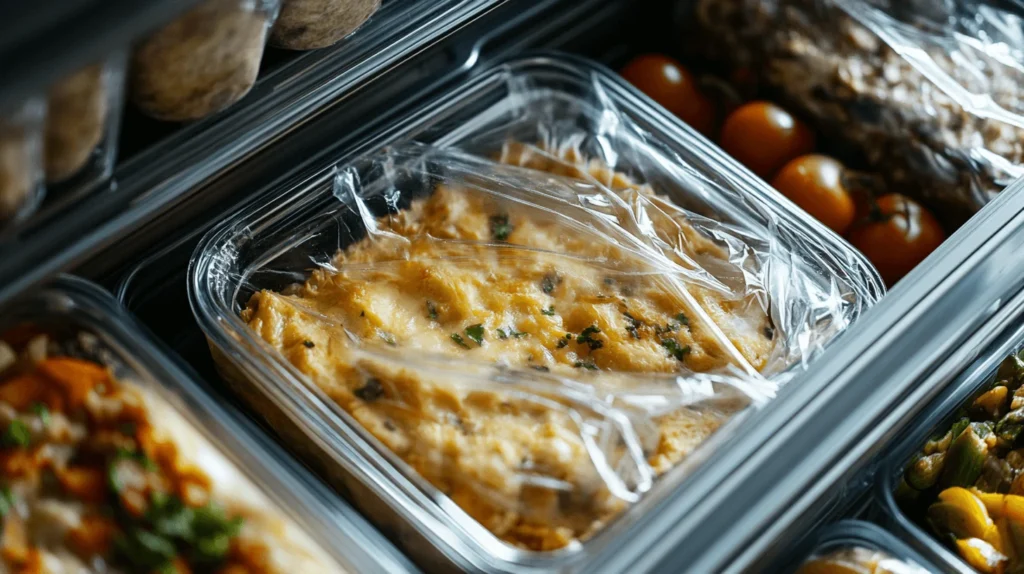When it comes to meal preparation, casseroles are incredibly convenient. Whether you’re planning a quick weeknight dinner or a relaxing weekend brunch, these adaptable dishes can fit any occasion. However, if your recipe includes raw eggs, you might wonder: Is it possible to prepare a casserole with raw eggs in advance? This is a common concern for those balancing meal prep with food safety.
In this guide, we’ll cover all the essentials for making casseroles with raw eggs ahead of time. From understanding how eggs contribute to the dish to practical tips on safe storage, cooking, and reheating, we’ll provide all the information you need. Additionally, we’ll address common questions and share some popular casserole recipes to inspire your next meal. Let’s get started!
Table of Contents
Understanding the Role of Raw Eggs in Casseroles
What Role Do Raw Eggs Play in Casseroles?
Eggs are the unsung heroes of casseroles with raw eggs, acting as a binding agent that holds all the ingredients together. They create a creamy, cohesive texture that makes casseroles with raw eggs so satisfying. Without eggs, many recipes would crumble apart or lack the signature richness we associate with these dishes.
For tips on getting the best results with casseroles, take a look at Why Is My Breakfast Casserole Soggy?, which provides insights into avoiding common issues with moisture balance.
Is it Safe to Use Raw Eggs in Make-Ahead Recipes?
The safety of casseroles with raw eggs often raises concerns, especially when preparing meals in advance. While raw eggs are generally safe when handled properly, they are perishable and can harbor bacteria like Salmonella if not stored correctly. This is why it’s crucial to follow food safety guidelines, such as using pasteurized eggs and refrigerating the casserole with raw eggs promptly after preparation. Proper handling ensures that the dish stays safe and enjoyable for everyone to savor.
Curious about other egg-based dishes? Explore Baked Egg Casserole Made with Crackers for a unique twist on the traditional casserole recipe. This variation adds crunch and texture to the dish, making it a flavorful and exciting option for your next meal.
Why Timing Matters When Preparing Casseroles with Eggs
Timing is crucial when preparing casseroles that include raw eggs. Proper cooking time ensures the eggs are fully set and safe to eat, while also achieving the desired texture and consistency. Preparing them too far in advance can lead to texture changes or even spoilage. Refrigeration helps slow down bacterial growth, but it’s best to bake the casserole within 24 hours for maximum freshness and safety. Understanding this balance ensures that your dish is both flavorful and safe to enjoy.
Preparing a Make-Ahead Casserole with Raw Eggs
Step-by-Step Guide to Preparing the Casserole Base

Preparing the base is the first step when making a casserole ahead of time. Begin by mixing your raw eggs with other wet ingredients, such as milk, cream, or broth, depending on the recipe. Whisking these together ensures even distribution throughout the casserole. Next, combine this mixture with your dry ingredients, like bread cubes, pasta, or rice, and any protein or vegetables you plan to include. Layer everything evenly in your casserole dish to ensure consistent cooking. Learn more about ingredient pairing in casseroles with How Do You Make Paula Deen’s Scalloped Potatoes?, which highlights rich and creamy preparation techniques.
How to Store a Casserole with Raw Eggs Safely
Once your casserole is assembled, it’s crucial to store it correctly. Cover the dish securely with plastic wrap or aluminum foil to prevent exposure to air, which can cause the eggs to dry out or promote bacterial growth. Store the casserole in the coldest part of your refrigerator, ideally at or below 40°F (4°C), to maintain its safety and freshness.
Tips for Preventing Separation or Texture Changes
Raw eggs can sometimes separate or cause a watery texture in make-ahead casseroles. To avoid this, use fresh, high-quality eggs and whisk them thoroughly with your other ingredients. Adding a small amount of cornstarch or flour to the egg mixture can also help stabilize the texture. Finally, avoid overloading the casserole with wet ingredients, as this can lead to sogginess when baked.
Cooking and Reheating Casseroles Made Ahead of Time
Proper Baking Techniques for Egg-Based Casseroles

When it’s time to bake your casserole, preheat your oven to the temperature specified in your recipe, usually between 350°F and 400°F. Baking from the refrigerator? Let the casserole sit at room temperature for 15–20 minutes to avoid uneven cooking. Cover the dish tightly with plastic wrap or aluminum foil to protect it from air exposure, which can lead to the eggs drying out or encourage bacterial growth.
Reheating Tips to Maintain Flavor and Texture
Reheating a pre-made casserole can be tricky if you want to maintain its flavor and texture. The best way to reheat is in the oven at 325°F, covered with foil to prevent drying out. For smaller portions, a microwave works, but be sure to use a lower power setting and stir occasionally to avoid hot spots. Adding a splash of milk or broth before reheating can help restore moisture.
Avoiding Common Mistakes When Cooking Pre-Made Casseroles
One common mistake is overcooking the casserole, which can cause the eggs to curdle and the dish to become rubbery. Use a food thermometer to check that the internal temperature reaches 160°F, ensuring the eggs are fully cooked but not overdone. Another pitfall is forgetting to grease the casserole dish, which can make cleanup a nightmare.
Benefits and Drawbacks of Using Raw Eggs in Make-Ahead Casseroles
Advantages of Preparing Casseroles in Advance
Make-ahead casseroles are incredibly convenient, especially for busy families or holiday gatherings. Preparing them ahead saves time and reduces stress on the day of your event. Raw eggs, in particular, contribute to a creamy, cohesive texture that’s hard to replicate with other ingredients. Plus, casseroles can be customized to suit any dietary preference or occasion.
Potential Risks and How to Mitigate Them
Despite their benefits, casseroles with raw eggs come with some risks. Improper storage or handling can lead to spoilage or foodborne illness. To mitigate these risks, always use fresh, pasteurized eggs and refrigerate the dish promptly. Additionally, avoid leaving the casserole at room temperature for more than two hours, as this increases the chance of bacterial growth.
Comparing Raw Eggs to Other Binding Agents
While raw eggs are a classic choice, there are alternatives for those who prefer not to use them. Ingredients like yogurt, silken tofu, or even mashed potatoes can act as binding agents in casseroles. However, these substitutes may alter the texture and flavor of the dish, so they’re best used in recipes where eggs aren’t the star ingredient.
Popular Casserole Recipes That Use Raw Eggs
Classic Breakfast Casserole with Eggs and Cheese
A breakfast casserole is a timeless favorite that showcases the versatility of raw eggs. Combine whisked eggs with milk, shredded cheese, and diced vegetables like bell peppers or onions. Add cooked sausage or bacon for extra flavor, and pour the mixture over cubed bread. Let it sit overnight in the fridge to soak, then bake to perfection in the morning.
Vegetarian Casserole Options
For those seeking a meat-free option, a vegetarian egg casserole is a delicious choice. Use ingredients like spinach, mushrooms, zucchini, and feta cheese to create a nutrient-packed dish. Pair these with quinoa or whole-grain bread for added texture and flavor. The eggs provide the perfect binding element, making this casserole both hearty and satisfying.
Protein-Packed Casseroles for Dinner
Egg-based casseroles aren’t just for breakfast—they make a fantastic dinner option too. Try a chicken and broccoli casserole with a creamy egg base, or opt for a Tex-Mex-inspired version with ground beef, black beans, and a sprinkle of chili powder. These dishes are filling, flavorful, and perfect for feeding a crowd.
Expert Tips for Success with Make-Ahead Casseroles
How to Choose the Right Ingredients
The success of your casserole starts with the ingredients you choose. Opt for fresh, high-quality eggs, and pair them with complementary flavors. For example, sharp cheeses like cheddar or Gruyère add depth, while fresh herbs like parsley or thyme enhance the overall taste. Avoid using overly watery vegetables, as they can dilute the casserole’s texture.
Seasoning Tips for Enhanced Flavor
Seasoning is key to a flavorful casserole. Don’t skimp on salt, pepper, or spices like paprika and garlic powder. If your recipe includes bland ingredients like potatoes or rice, be sure to season them generously. Layering flavors at each step of preparation ensures a well-balanced dish.
Balancing Moisture Levels in Egg-Based Recipes
Achieving the right moisture balance is essential for a successful casserole. Too much liquid can make the dish soggy, while too little can cause it to dry out. Stick to the ratios outlined in your recipe, and don’t be afraid to adjust based on the ingredients you’re using. For example, reduce the amount of milk if you’re adding juicy vegetables like tomatoes.
Storing and Freezing Casseroles with Raw Eggs

Can You Freeze a Casserole with Raw Eggs?
Yes, you can freeze a casserole with raw eggs, but it requires careful preparation. Freezing works best for casseroles with a sturdy base, like bread or pasta, as these hold up well during thawing and baking. Avoid freezing casseroles with delicate vegetables, as they may become mushy.
Best Practices for Freezing and Thawing
To freeze, assemble your casserole in a freezer-safe dish and cover it tightly with plastic wrap and foil. Label it with the date to keep track. When you’re ready to bake, transfer the casserole to the refrigerator and allow it to thaw overnight. Bake as directed, adding a few extra minutes to account for the cooler starting temperature.
How Long Can You Store a Make-Ahead Casserole?
In the refrigerator, a casserole with raw eggs can be safely stored for up to 24 hours before baking. If frozen, the casserole can last up to three months. Always check for signs of spoilage, such as an off smell or discoloration, before baking.
FAQs About Raw Eggs in Casseroles
Is It Safe to Eat Casseroles with Raw Eggs?
To ensure safety, casseroles with raw eggs can be consumed as long as they are baked to reach an internal temperature of 160°F (71°C). This temperature ensures that harmful bacteria, such as Salmonella, are effectively killed. Using pasteurized eggs can further reduce the risk of foodborne illness, as they have been treated to eliminate pathogens.
How Long Can You Keep a Casserole in the Refrigerator Before Baking?
A casserole with raw eggs should be baked within 24 hours of being refrigerated.
Storing it longer can increase the risk of bacterial growth and compromise both safety and quality. If you need to store it for an extended period, consider freezing it instead.
What Are the Alternatives to Using Raw Eggs in Casseroles?
If you prefer to avoid raw eggs, you can use alternatives such as silken tofu (blended until smooth), yogurt or sour cream, or commercial egg replacements (e.g., flaxseed meal, chia seeds, or store-bought egg substitutes). Keep in mind that these alternatives may slightly alter the texture and flavor of the casserole.
Can You Substitute Egg Whites or Egg Replacements?
Yes, you can substitute egg whites or commercial egg replacements in most casserole recipes. However, egg whites alone may result in a less rich and creamy texture compared to using whole eggs. Egg replacements can work well but may also change the dish’s consistency or flavor profile. If you’re experimenting with substitutions, it’s a good idea to test the recipe first to ensure the desired outcome.
Conclusion Thoughts on Making Casseroles with Raw Eggs Ahead of Time
Making casseroles with raw eggs ahead of time is a fantastic way to simplify meal prep while still delivering a delicious, satisfying dish. By following proper storage and cooking techniques, you can ensure your casserole is both safe and flavorful. Whether you’re preparing a hearty breakfast, a vegetarian option, or a protein-packed dinner, the versatility of casseroles makes them a go-to choice for any occasion.
Remember to always handle raw eggs with care, refrigerate promptly, and bake to the recommended temperature. Don’t be afraid to experiment with ingredients and flavors to create a dish that suits your taste. With the right preparation and a little creativity, casseroles can become a staple in your meal rotation. Happy cooking!


1 thought on “Can You Make a Casserole with Raw Eggs Ahead of Time? A Complete Guide”